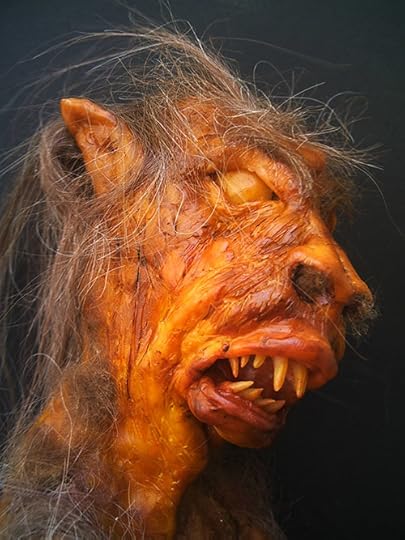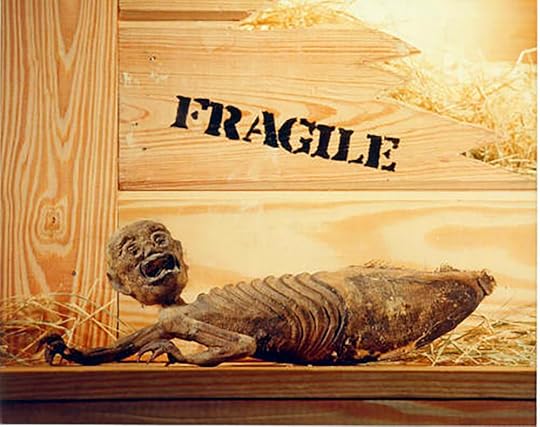Ripley Entertainment Inc.'s Blog, page 388
September 22, 2017
Rapture Pet Care Takes Care of Your Pets After the Apocalypse
Featured in Ripley's Believe It or Not!

We hear news about the impending apocalypse everywhere. In news reports, Mayan calendars, the Bible, and even those guys on the street corner. Despite all the warnings, few people have truly prepared. We don’t mean preparing your souls for holy transcendence; we mean taking care of your pet’s needs when you’re gone.
While your immortal soul may go to heaven, nothing in Biblical scriptures mentions anything about cat or dog going as well. Many Christians have voiced concerns about their pets being stuck inside or going without food when they ascend. That’s where After the Rapture Pet Care comes in.
“The rapture will be a joyous time for Christians. But when we’re gone, what will happen to our pets?”—After the Rapture Pet Care
Thank Heathens
For just $10, you can register up to three pets for volunteer caretakers to look after. Volunteers for the service are made up of atheists and members of non-Christian religions. The company points out that these volunteers love animals so much, that they’ve agreed to care for animals after an apocalypse they don’t even believe in.
Pet caretakers are matched with rapture-abandoned pets based on location and animal type. Some volunteers aren’t picky, but you’ve got to imagine many have their own pets already, and yours will have to get along. They accept dogs, cats, fish, birds, reptiles, and insects that can be taken care of in the home. They will register horses and larger animals, but don’t guarantee service if needed.
The Plan
While they admit there may be some confusion when all Christians disappear, most people will remain on Earth. After the Rapture of the Church and all Christian mortals are brought to heaven, the arrival of the anti-Christ and an idol-God brings a 42 month of stability to the world, according to Revelations 13:1-18. That’s plenty of time to take care of your abandoned pets before the iron-rod rule of the white horse-riding Word of God.
Some people think this time is wasted on pets in a time when these people should be concerned with the fate of their immortal souls, but they believe their volunteers can witness salvation and care for pets.

The anti-Christ from the fresco at Osgovo Monastery.
For Real?
Many people have accused After the Rapture pet Care of being just a scam against Christians, but they maintain they will execute their plan in the wake of an apocalypse. Their small fee seems more than fair for a responsible pet owner just in case the worst happens.
Other services have popped up offering the same amenities, but are not legitimate services. An NPR investigation in 2012 found that rival company Eternal Earth-Bound Pets, USA was no more than a hoax after it was subpoenaed by insurance companies.
Buy Now
While no predictions of exactly when the rapture will occur have been independently verified or corroborated, it could be soon. According to Christian researcher David Meade, the rapture will start this Saturday. We couldn’t begin to explain how he knows, so we’ll let his words speak for themselves:
“Jesus lived for 33 years. The name Elohim, which is the name God gave to the Jews, was mentioned 33 times. It’s a very biblically significant, numerologically significant number. I’m talking astronomy. I’m talking the Bible… and merging the two.”—David Meade
Meade believes a secret planet called Niburu will be passing Earth and kicking off the end of the world, which is all the more reason to register your pets now.
Source: Rapture Pet Care Takes Care of Your Pets After the Apocalypse
CARTOON 09-22-2017
September 21, 2017
Or Not: Do Lemmings Jump to Their Deaths?
Featured in Ripley's Believe It or Not!

Or Not
In today’s world many misconceptions have been perpetuated—becoming modern day “facts”—when, in reality, myths and hearsay have taken over. Sorry to burst your bubble, but in this weekly column, Ripley’s puts those delusions to the test, turning your world upside down, because you can’t always…Believe It!
Today: Lemmings Jumping to Their Deaths
Are Lemmings Cliff-Jumping Maniacs?
Lemmings are hamster-sized rodents that live in the snowy Arctic. They have a reputation for participating in massive migrations, where herds of the tiny critters mindlessly leap off of cliffs to their deaths. Depending on who’s telling, they’re either too unyielding in their stubborn march in one direction to stop, or they just aren’t intelligent enough to know any better.
This idea of lemming behavior has become so prevalent that it’s fallen into popular jargon, where calling someone a lemming means they are unthinking and prone to join mass movements.
Disney’s Role in the Myth
The lemming myth was popularized by none other than the Walt Disney Company in the Academy Award-winning nature documentary, White Wilderness. Released in 1958, the film was part of a series of movies showing “true to life” depictions of animals in their natural environments. The film’s depiction of lemmings, however, was steeped in deception.
The filming of these Norwegian lemmings, for example, was done in Alberta, Canada. Rumor has it that the Walt Disney company paid a dollar per lemming to Inuit hunters to provide the rodents. The film stages these lemmings in their march to death. In the film, they show hundreds of lemmings spilling off a cliff into the ocean to drown.
“A kind of compulsion seizes each tiny rodent and, carried along by an unreasoning hysteria, each falls into step for a march that will take them to a strange destiny.”—narration from White Wilderness.
What we don’t see—just off frame—are the filmmakers pushing the lemmings off the cliff. The whole thing is a fabrication. The “ocean” they jumped into was even just a river! The Canadian Broadcast Corporation even found that the lemmings were made to run on a snow-covered lazy-susan to make their numbers look larger for the film.
Real Lemming Behavior
Lemmings live in the tundra, where they build tunnels underground during long periods of snow. While winter rages on, these rodents travel and copulate under the snow, expanding their populations. As the thaw of spring comes, all of these lemmings can find themselves above ground, and with too many mouths to feed.
They sometimes make enormous migrations looking for new food sources. Depending on climate, predators, and food, a lemming population can increase by ten-fold over the winter season. In their search for food, they have been seen swimming across lakes en masse, and some have been observed drowning, but this far from mass suicide or intentional cliff-jumping.
“It’s a complete urban legend.”—Thomas McDonough, Research Biologist at Alaska Department of Fish and Game.
CARTOON 09-21-2017
September 20, 2017
The Man Who Survived Execution: El Fusilado
Featured in Ripley's Believe It or Not!

Sentenced to execution by firing squad during the 1915 Mexican Revolution, Wenseslao Moguel survived despite being shot nine times, the final coup de grâce, a bullet shot through his head by an officer to ensure death. His story of survival was so incredible that it caught the eye of Robert Ripley himself.
“Pancho” Villa was one of the most famous leaders of the Mexican Revolution. After his defeat by the Constitutionalists in 1915, Northern rebels faced harsh punishment by regional de facto armies. One of the unfortunate casualties of was was Wenseslao Moguel. Branded as a traitor, Wenseslao was sentenced—without trial—to execution by firing squad.
During the Mexican Revolution, a firing squad was the preferred means of execution. The squad was comprised of nine soldiers who would all fire their weapons at the same time. The tenth shooter, an officer, was to aim at one of the prisoner’s vital organs and deliver the coup de grace—the kill shot.
This was Wenseslao’s lucky day. March 18, 1915. The Federales took their positions and fired—even the tenth. Assuming he was dead, the job was done, or so they thought. Wenseslao survived! Although in excruciating pain, he waited for his executioners to leave and, miraculously, left the scene to make his way to safety.
Survival
Though horribly disfigured, Wenseslao Moguel went on to live a full life, and became legendary thanks to Robert L. Ripley, founder of Ripley’s Believe It or Not!. He appeared on his 1937 radio show and at the Cleveland, Ohio, odditorium. He was dubbed him El Fusilado—the executed one.

CARTOON 09-20-2017
September 19, 2017
Want to Be the next Marilyn Monroe?
Featured in Ripley's Believe It or Not!

You can now have a little bit of American and Hollywood history when you visit our Grand Prairie Ripley’s Believe It or Not! Odditorium starting September 22!
As featured on the TODAY show, you can see the world’s most expensive dress. The provocative flesh-colored gown made history when Marilyn Monroe famously sang “Happy Birthday” to President John F. Kennedy for his 45th birthday at Madison Square Garden, on May 19, 1962.
Believe It or Not!
On November 17, 2016, we set a new Guinness World Record for the most expensive dress sold at auction when we acquired the dress from Julien’s Auctions for a staggering $4.8 million.
Add in auction fees, and the dress cost over $5 million, making it the most expensive dress in the world!

Are you a Marilyn?

Do you have what it takes to be Ms. Monroe? If so, you won’t want to miss our Marilyn Monroe look-a-like contest at our Grand Prairie Ripley’s Believe It or Not! Odditorium. We have some pretty exciting prizes for the winners.
You can enter every Saturday in October as we will be showing a free outdoor Marilyn Monroe movie. Entries for the look-a-like competition will begin at 6:30 – 7:00 p.m. at the ticket booth.
Movies will start at 7:30 p.m., and will be shown outdoors.
*If weather permits*
October 7th: Gentlemen Prefer Blondes
October 14th: How to Marry a Millionaire
October 21st: Some Like It Hot
October 28th: The Seven Year Itch

Did You Know This about the Dress?
The dress designer was Jean Louis.
The original sketch of the dress was drawn by none other than a young Bob Mackie in his first job out of college.
The dress has over 6,000 hand-sewn rhinestones.
Marilyn Monore was sewn into the dress.
Edward Meyer, Ripley’s VP of Exhibits and Archives–who has been acquiring items for the company for more than 35 years–placed the winning bid for the iconic dress.
The dress’s winning bid was $4.8 million!

Shatter Yourself with Marilyn
Get your Monroe on at our Grand Prairie Ripley’s Believe It or Not! Odditorium where you can also experience our unique attractions including state-of-the-art Ripley’s 7D Moving Theater, our mind-bending Ripley’s Mirror Maze, our challenging Ripley’s LaseRace, our sweet Ripley’s Candy Factory, and meet the stars at Louis Tussaud’s Palace of Wax!
Unable to make it? Don’t worry; you can own just a little piece of Monroe’s dress in our new annual Ripley’s Believe It or Not! Shatter Your Senses! You’ll learn all about the dress and get an exclusive backstage pass to the most expensive dress ever sold at auction!
The Star Sand Beaches of Japan
Featured in Ripley's Believe It or Not!

You don’t have to look to the sky to see stars in Okinawa, Japan—just visit the islands of Taketomi, Hatoma, and Iriomote, where star‑shaped sand sprinkles the beaches! The stars are actually the exoskeletons of tiny organisms known as Foraminifera. When Foraminifera die, their shells remain in the sea and are washed ashore by the tides.

SENSING YOU WANT MORE?
Filled with remarkable photos and over 1,500 all new—all true—stories to immerse yourself in, Ripley’s Believe It or Not! Shatter Your Senses! is the newest book in the bestselling series from Ripley Publishing—so incredible you won’t believe your eyes…or ears…or nose!
Spark your senses here, on the blog, weekly for a feature from the 2018 annual, Ripley’s Believe It or Not! Shatter Your Senses! and follow us on social media for a chance to win a copy, among other unbelievable prizes!
Source: The Star Sand Beaches of Japan
CARTOON 09-19-2017
September 18, 2017
The Origins of Gaff Taxidermy as Historical Oddities
Featured in Ripley's Believe It or Not!

Have you ever been fooled by the legend of the jackalope, Fiji mermaid, or furry trout? How couldn’t you? Tchotchke shops and restaurants are full of undeniable proof that these made-up creatures exist.
Clever taxidermists have long been in on the joke and can pull all kinds of tricks to bring mythical creatures, like Bavaria’s wolpertinger, to life.

One of many versions of a Wolpertinger.
What Is a Gaff?
Taxidermists refer to their made-up creations as gaffs because they are meant to hook someone’s attention and make them wonder.
While many claim taxidermy gaffs to be forgeries, some gaff taxidermists disagree.
A Taxidermist’s Take on Gaffs
Though many gaff taxidermists are known for their mythical creations, most don’t see it as a means to deceive people. Doug Higley, renowned for his chupacabra gaffs, for example, never meant for his creations to be marketed as “real,” but instead to let people make their own decision about what it is. He famously calls his work the “Chupacabra?” emphasizing the importance of the question mark.

“Chupacabra?”
Taxidermy gaffs are a fun suspension of disbelief in taxidermists’ eyes. They want people to have fun imagining the mystery of their creations rather than just being a simple statement of falsehood.
Gaffs at Ripley’s
While the multi-headed and appendaged taxidermy displays in our many odditoriums are indeed genuine, we do love including some historic sideshow gaffs with information about their mythological origins:
The Fiji Mermaid
Perhaps the most famous taxidermy gaff, the Fiji mermaid was presented by P. T. Barnum in 1842. By convincing newspapers to do stories on his “real” mermaid, Barnum gained legitimacy for his creation and even managed to stump naturalists for a long while. In the meantime, similar mermaids popped up in smaller sideshows.

Researchers now believe Japanese sailors made the original mermaid in 1822 by sewing a monkey torso to a fish tail. Robert Ripley presented the Fiji mermaid at his odditorium in the 1930s, but his presentation debunked the hoax. The myth itself was the believe it or not.
“There’s a sucker born every minute.”—a phrase often associated with P. T. Barnum
Fur-Covered Trout
The story claims that these trout grow long, fluffy, white hair to keep warm in the frigid temperatures of Iceland, Canada, and… Arkansas? The fish supposedly from Iceland were “bad omens” and allegedly turned people into dinosaurs if they ate them, while the Arkansas fish were rumored to be the victims of a hair tonic spill upriver.

Jackalope
The gaff of the American West is the spritely jackalope. The fusion of a rabbit with a deer, these critters are rumored to be so dangerous that frontier hunters were advised to wear metal stovepipes on their legs to keep from being gored.
In Douglas, Wyoming, they even offer jackalope hunting licenses to tourists. Legend has it that jackalopes can only be caught on June 31st—a day that doesn’t exist.

Source: The Origins of Gaff Taxidermy as Historical Oddities
Ripley Entertainment Inc.'s Blog
- Ripley Entertainment Inc.'s profile
- 52 followers







